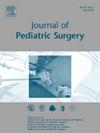已知肾脏或泌尿系统异常患者中勒氏管异常的筛查方法:回顾性图表回顾。
IF 2.5
2区 医学
Q1 PEDIATRICS
引用次数: 0
摘要
简介/背景:在诊断为肾脏异常的女性患者中,约有20%至40%的患者同时存在本文章由计算机程序翻译,如有差异,请以英文原文为准。
Screening Practices for Müllerian Anomalies in Patients With Known Renal or Urologic Anomalies: A Retrospective Chart Review
Introduction/background
Approximately 20–40 % of females diagnosed with renal anomalies will have a coexistent Müllerian anomaly. Müllerian anomalies can have significant implications on reproductive health, however, no formal guidelines exist to direct screening practices for patients within this high-risk population.
Objective
This study aims to establish a baseline incidence and description of pelvic imaging practices among female patients with renal anomalies at a tertiary children's hospital.
Methods
Retrospective chart review of female patients aged 0–25 years with congenital renal anomalies who presented to a tertiary children's hospital between January 2015 and June 2022.
Results
A total of 212 patients met inclusion criteria. The most common congenital renal anomaly diagnoses included multicystic kidney disease (61, 28.8 %), renal agenesis (39, 18.4 %), and renal dysplasia/hypoplasia (36, 17.0 %). The average age of renal anomaly diagnosis was 8.6 years (SD = 5.8, range 0–20). Within this patient population, 125 (59.0 %) received at least one pelvic imaging study and 75 (35.4 %) reported an evaluation of reproductive structures. The most common imaging modality that evaluated reproductive structures was pelvic ultrasound (59/75, 78.7 %), which occurred on average at age 13.7 (SD 4.7). Uterine or vaginal anomalies were identified in 22/75 (29.3 %) patients who had their reproductive anatomy evaluated on imaging. Only one imaging study was ordered for the indication of Müllerian anomaly screening.
Discussion
Most female patients with renal anomalies do not receive imaging that evaluates reproductive anatomy. When imaging does occur, it is ordered for indications other than screening for Müllerian anomalies. Screening protocols need to be developed for early detection of Müllerian anomalies in this high-risk population.
Conclusions
Findings demonstrate that female patients with renal anomalies are not consistently screened for Müllerian anomalies despite the known association between these anomalies. Lack of guidelines at our tertiary institution may delay diagnosis and treatment of these conditions.
Study type
This study is a level 2 retrospective chart review.
求助全文
通过发布文献求助,成功后即可免费获取论文全文。
去求助
来源期刊
CiteScore
1.10
自引率
12.50%
发文量
569
审稿时长
38 days
期刊介绍:
The journal presents original contributions as well as a complete international abstracts section and other special departments to provide the most current source of information and references in pediatric surgery. The journal is based on the need to improve the surgical care of infants and children, not only through advances in physiology, pathology and surgical techniques, but also by attention to the unique emotional and physical needs of the young patient.

 求助内容:
求助内容: 应助结果提醒方式:
应助结果提醒方式:


